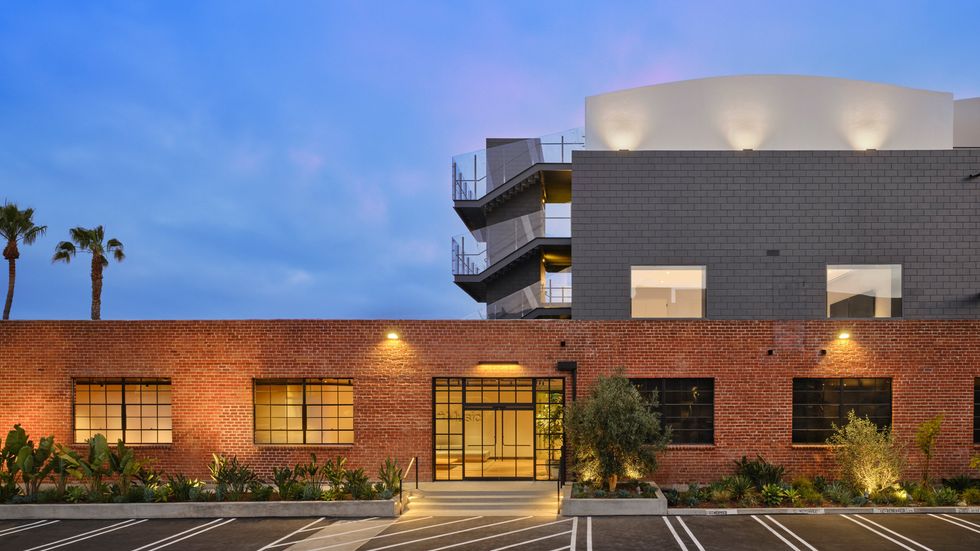

Get in the KNOW
on LA Startups & Tech
X
Courtesy of TRIPP
Tripp Gets a Step Closer To a Meditative Metaverse With New Funding, Acquisition
Keerthi Vedantam
Keerthi Vedantam is a bioscience reporter at dot.LA. She cut her teeth covering everything from cloud computing to 5G in San Francisco and Seattle. Before she covered tech, Keerthi reported on tribal lands and congressional policy in Washington, D.C. Connect with her on Twitter, Clubhouse (@keerthivedantam) or Signal at 408-470-0776.
Tripp, the virtual reality meditation startup that simulates psychedelic experiences, has raised $11.2 million in new Series A funding, the Los Angeles-based company announced Wednesday.
San Francisco-based BITKRAFT Ventures led the round and was joined by the Amazon Alexa Fund, Qualcomm, HTC, “Pokémon Go” developer Niantic and existing investor Mayfield. The new funding is an extension on Tripp’s initial $11 million Series A round last year and brings the startup’s total capital raised to more than $26 million.
Tripp also used the opportunity to unveil its acquisition of Eden, a VR-based world-building platform and online social hub created by video game developer Bearded Eye. It’s the latest in a series of acquisitions for the deal-happy Tripp, which in February scooped up EvolVR, a VR platform that allows people to meditate together via virtual avatars.
“Eden allows us to create and develop more premium live programming as we scale our growing mindfulness community,” Tripp co-founder Nanea Reeves said in an email to dot.LA. “Eventually, you will see Eden expand towards allowing our community members to offer their own experiences to the community.”
Tripp launched in 2018 as a VR platform that allowed people to meditate while looking at psychedelic, “Alice in Wonderland”-esque visuals like pulsating trees and rippling sand dunes. In the years since, the company has made its foray into the world of virtual, communal meditation; in November, it announced a partnership with Niantic to expand its platform via augmented reality (AR) offerings where people can interact and meditate together.
“Our main focus is currently on scaling our consumer offering at this stage in our company life cycle, but we have ongoing research initiatives in the categories of substance use disorder, anxiety reduction, PTSD and ADHD,” Reeves said in an email. “Early results are very promising, and I believe that digital therapeutics will be a big future opportunity for us that will greatly benefit from the cross-platform metaverse distribution footprint that we are continuing to build out now.”
From Your Site Articles
- VR Therapy App Tripp Acquires Meditation Startup EvolVR - dot.LA ›
- Tripp Raises $11 Million to Simulate Psychedelic Euphoria - dot.LA ›
- What Will Health Care Look Like in the Metaverse? - dot.LA ›
Related Articles Around the Web
Keerthi Vedantam
Keerthi Vedantam is a bioscience reporter at dot.LA. She cut her teeth covering everything from cloud computing to 5G in San Francisco and Seattle. Before she covered tech, Keerthi reported on tribal lands and congressional policy in Washington, D.C. Connect with her on Twitter, Clubhouse (@keerthivedantam) or Signal at 408-470-0776.
https://twitter.com/KeerthiVedantam
keerthi@dot.la
AirMap Will Help The FAA Design Its New Drone Tracking System
04:43 PM | May 06, 2020
Santa Monica-based drone operations company AirMap is among eight companies selected to help the Federal Aviation Administration establish technical requirements for Remote ID, a protocol that drones will be required to follow for broadcasting identification and location data while in flight.
The other companies include Airbus, Amazon, T-Mobile, Intel, OneSky, Skyward and Alphabet's drone subsidiary, Wing.
"The FAA will be able to advance the safe integration of drones into our nation's airspace from these technology companies' knowledge and expertise on remote identification," Transportation Secretary Elaine Chao said today in a news release.
Today's announcement comes months after the FAA put out a set of draft regulations and a request for information relating to Remote ID.
Remote ID would require drone manufacturers to make their products capable of sending out ID codes and location data during operation in national airspace. The rules would apply to all drones heavier than 8.8 ounces, and manufacturers would have to comply two years after the regulations take effect. Drone operators would have three years to phase out non-complying devices.
Drones without the Remote ID system could be flown only within special FAA-designated zones — usually the same sorts of places where hobbyists fly model airplanes.
Remote ID system proposed for drones in U.S. airspacewww.youtube.com
The eight companies named today will advise the FAA on the technical standards and radio frequencies that would support the Remote ID system. Those specifications will be announced when the FAA publishes its final rule on Remote ID. Then the FAA would begin accepting applications for entities to become Remote ID suppliers.
Assuming the process develops as the FAA envisions, Remote ID would become a fact of life for drone operation — and for enforcement of the rules governing drone operation. Nearly 1.5 million drones and 160,000 remote pilots are now registered with the FAA, and analysts say Remote ID could turn into a market generating $1.5 billion a year by 2029.
Seattle-based Amazon and Wing are already well-known for their work on drones designed for package delivery. Airbus has its own delivery-drone program known as Skyways. Intel, meanwhile, has been building drones optimized for remote monitoring. Several FAA-approved pilot projects are testing Intel's drones as well as Intel's Bluetooth-enabled identification system, known as Open Drone ID.
AirMap, OneSky (a business unit of Analytical Graphics Inc.) and Skyward (a Verizon subsidiary) are working on traffic management systems that are optimized to keep track of drone operations.
T-Mobile has been providing the connectivity for at least three pilot projects involving drones, and is looking to expand its involvement in the drone industry with the rise of 5G networks.
Not everyone is happy with the FAA's proposed plan for Remote ID: DJI, one of the world's largest drone manufacturers, sounded off about its objections in a January blog posting.
"DJI wants governments to require Remote ID for drones, but the FAA has proposed a complex, expensive and intrusive system that would make it harder to use drones in America, and that jeopardizes the success of the Remote ID initiative," said Brendan Schulman, DJI's vice president of policy and legal affairs. "Instead, we support a simpler, easier, and free version of Remote ID that doesn't need a cellular connection or a service subscription."
Will the FAA's new technology partners come up with a different plan, or stick with the system as proposed? Stay tuned.
This story first appeared on GeekWire.
From Your Site Articles
- California Wildfire Drones Join the Frontlines - dot.LA ›
- Drone Detection Technology Debuts at LAX - dot.LA ›
Related Articles Around the Web
Read moreShow less
Alan Boyle, GeekWire
GeekWire contributing editor Alan Boyle is an award-winning science writer and veteran space reporter. Formerly of NBCNews.com, he is the author of "The Case for Pluto: How a Little Planet Made a Big Difference." Follow him via CosmicLog.com, on Twitter @b0yle, and on Facebook and MeWe.
Tinder, Starlink, and Apple’s New Studio: This Week in LA
10:27 AM | July 04, 2025
🔦 Spotlight
Happy Independence Day, Los Angeles! 🇺🇸
While you're celebrating freedom, here are some electrifying updates lighting up LA’s tech, satellite, and music scenes:
🔥 Tinder mandates Face Recognition in California

Tinder is now requiring all new users in California to complete a biometric face check, a brief video selfie processed via FaceTec, to verify profiles are genuine. The video is deleted post-verification, though an encrypted face map remains while the account is active. This West Hollywood based move could redefine trust, safety, and privacy in mainstream consumer apps.
🌐 Starlink clears hurdle to launch in India
Elon Musk’s SpaceX backed Starlink has cleared most regulatory and licensing hurdles with India’s Department of Telecommunications, marking a key step toward launching satellite broadband in one of the world’s fastest growing markets. Final approvals from the national space regulator are pending, and services, expected to deliver high speed connectivity to underserved regions, could launch in the coming months. This is a major milestone for Starlink’s global expansion.
🎧 Apple Music opens Culver City creative hub

Apple Music is celebrating its anniversary by launching a brand new 15,000 square foot, three story studio in Culver City. The facility, featuring a 4,000 square foot soundstage, spatial audio suites, podcast booths, and more, is designed by Eric Owen Moss and slated to open mid August. It solidifies LA’s reputation as a creative powerhouse and reaffirms Apple’s commitment to investing in and nurturing our city's cultural ecosystem.
From dating apps to deep space to sound stages, LA isn’t just watching the future unfold, we’re building it.
Here’s to independence, imagination, and everything this city dares to launch next. Happy Fourth, Los Angeles.
🤝 Venture Deals
LA Companies
- Castelion has raised a $350M Series B round led by Lightspeed Venture Partners alongside Altimeter Capital to scale its hypersonic missile production capabilities. The El Segundo-based defense startup plans to use the funds to expand manufacturing, accelerate testing through its SpaceX-inspired rapid development model, and position itself as a cost-effective supplier of hypersonic weapons to the U.S. military and its allies. - learn more
- Earth Sama, a Calabasas, California–based climate-tech platform that helps rural farming and Indigenous communities generate and manage carbon credits, secured investment from Omtse Ventures. The funding will support the rollout of Earth Sama’s blockchain-powered field app, climate-creator platform, and smart-contract tools to scale community-led carbon credit projects globally under the Paris Agreement’s Article 6.4 framework. - learn more
LA Venture Funds
- Plassa Capital participated in Metafide’s $3.275M funding round. Miami based Metafide, the creator of SURGE, a gamified trading platform that combines AI neural networks and human insight, will use the funds to scale and launch SURGE into the market. - learn more
- BOLD Capital Partners participated as a founding investor in Syntis Bio’s $33M Series A round, with an additional $5M in NIH grants. The Boston-based biotech is developing oral therapies for obesity and rare diseases, and the funding will help advance its SYNT platform, moving its lead obesity treatment, SYNT-101, into Phase 1 trials and supporting development of SYNT-202 for homocystinuria. - learn more
- BAM Ventures participated in Cred’s $15M seed round for its predictive intelligence startup. San Francisco based Cred uses AI to unify company data with real time market signals and deliver actionable insights for sales and operations. The funding, led by defy.vc, will be used to scale Cred’s platform, expand its customer base, and grow team and product capabilities. - learn more
- BOLD Capital Partners participated in Gallant’s $18M Series B round to advance its ready-to-use stem cell therapies for pets. The funding, led by Digitalis Ventures with additional support from NovaQuest Capital, will help Gallant bring its off-the-shelf regenerative treatments to market. - learn more
- Rebel Fund joined the seed round for Rocketable, contributing to the $6.5M raised to build a portfolio of fully automated SaaS companies. San Francisco-based Rocketable, backed by True Ventures and others, uses AI agents to operate acquired software products, and Rebel’s support will help scale both the platform and acquisitions. - learn more
LA Exits
- Leasepath, a cloud-first provider of equipment lease and loan management software, has been acquired by Solifi to enhance its mid-market offerings. The deal allows Solifi to expand Leasepath’s Microsoft Dynamics-based platform into new global markets while keeping Leasepath’s team and leadership in place. - learn more
Read moreShow less
RELATEDTRENDING
LA TECH JOBS


